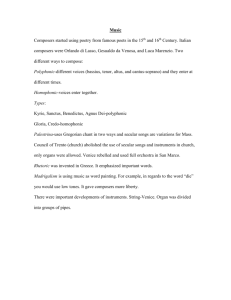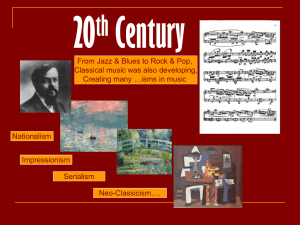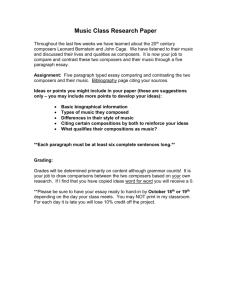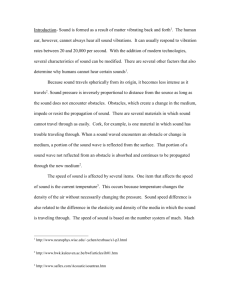6th grade classroom music
advertisement
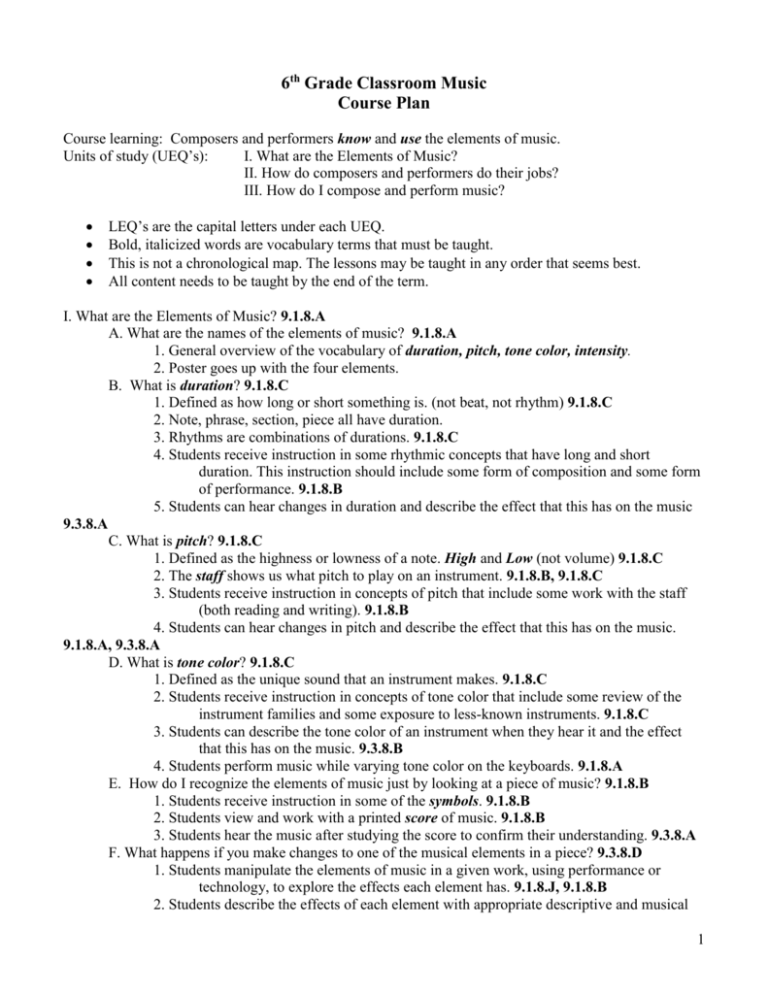
6th Grade Classroom Music Course Plan Course learning: Composers and performers know and use the elements of music. Units of study (UEQ’s): I. What are the Elements of Music? II. How do composers and performers do their jobs? III. How do I compose and perform music? LEQ’s are the capital letters under each UEQ. Bold, italicized words are vocabulary terms that must be taught. This is not a chronological map. The lessons may be taught in any order that seems best. All content needs to be taught by the end of the term. I. What are the Elements of Music? 9.1.8.A A. What are the names of the elements of music? 9.1.8.A 1. General overview of the vocabulary of duration, pitch, tone color, intensity. 2. Poster goes up with the four elements. B. What is duration? 9.1.8.C 1. Defined as how long or short something is. (not beat, not rhythm) 9.1.8.C 2. Note, phrase, section, piece all have duration. 3. Rhythms are combinations of durations. 9.1.8.C 4. Students receive instruction in some rhythmic concepts that have long and short duration. This instruction should include some form of composition and some form of performance. 9.1.8.B 5. Students can hear changes in duration and describe the effect that this has on the music 9.3.8.A C. What is pitch? 9.1.8.C 1. Defined as the highness or lowness of a note. High and Low (not volume) 9.1.8.C 2. The staff shows us what pitch to play on an instrument. 9.1.8.B, 9.1.8.C 3. Students receive instruction in concepts of pitch that include some work with the staff (both reading and writing). 9.1.8.B 4. Students can hear changes in pitch and describe the effect that this has on the music. 9.1.8.A, 9.3.8.A D. What is tone color? 9.1.8.C 1. Defined as the unique sound that an instrument makes. 9.1.8.C 2. Students receive instruction in concepts of tone color that include some review of the instrument families and some exposure to less-known instruments. 9.1.8.C 3. Students can describe the tone color of an instrument when they hear it and the effect that this has on the music. 9.3.8.B 4. Students perform music while varying tone color on the keyboards. 9.1.8.A E. How do I recognize the elements of music just by looking at a piece of music? 9.1.8.B 1. Students receive instruction in some of the symbols. 9.1.8.B 2. Students view and work with a printed score of music. 9.1.8.B 3. Students hear the music after studying the score to confirm their understanding. 9.3.8.A F. What happens if you make changes to one of the musical elements in a piece? 9.3.8.D 1. Students manipulate the elements of music in a given work, using performance or technology, to explore the effects each element has. 9.1.8.J, 9.1.8.B 2. Students describe the effects of each element with appropriate descriptive and musical 1 terminology. 9.1.8.C, 9.3.8.A G. What is intensity? 1. Defined as the level of tension in a piece of music. 9.1.8.C 2. Duration, Pitch, Tone Color are major players in creating Intensity 3. Can be created in many ways: volume, pitch, tone color, tempo, repetition, etc. 4. Students listen to many different pieces of music that have differing levels of intensity. 9.3.8.A 5. Students describe the intensity of a piece of music using appropriate vocabulary. 9.1.8.C, 9.3.8.D II. How do composers and performers do their jobs? 9.1.8.H is covered in general over the entire unit. A. How do composers write music? 1. Students work as a class to manipulate the Elements of Music and create an original piece of music. 9.1.8.A, 9.1.8.B, 9.1.8.C, 9.1.8.E, 9.1.8.G, 9.1.8.J 2. Students read about/watch/listen to what some composers have said about the process of composition. (John Williams, Wynton Marsalis, ex.) 9.1.8.F 3. Students revise and edit their classroom composition. 9.1.8.B, 9.1.8.C, 9.3.8.A, 9.1.8.D, 9.1.8.F, B. What do composers know that helps them to write “good” music? 1. Students receive instruction in basic form, basic concepts of harmony, basic texture, phrase, and style. 9.1.8.A, 9.1.8.C, 9.3.8.C, 2. Students experience guided listening to identify these principles at work. 9.3.8.A, 9.3.8.B, 9.8.3.C, 9.8.3.D, 9.8.3.E, 9.8.3.F, 9.8.3.G 3. Students apply new knowledge to further edit their classroom composition. 9.1.8.A, 9.1.8.B, 9.3.8.A 4. Students analyze how a composer creates mood through the use of the elements and principles of music. 9.3.8.A, 9.3.8.B, 9.3.8.D C. How does technology help composers? 1. Students learn about software (Finale, Musictime, Printmusic, Acid Xpress, Garage Band) and hardware (MIDI keyboards, digital recordings) that aid composition. 9.1.8.J 2. Students experience one form of technology as it relates to composition. 9.1.8.J D. How performers make music? 1. Students read about/watch/listen to what some performers have said about their approach to performing. 9.1.8.G, 9.3.8.A, 9.4.8.A 2. Students review the staff and the reading of music. 9.1.8.A, 9.1.8.B 3. Students create a list of habits for performers: see the music’s form and style, observe the markings that the composer has made, employ appropriate techniques that create intensity, determine the expressive qualities needed for the performance, study the score, practice to perfect, work on the hardest parts the most, practice “as if”, etc. 9.1.8.B, 9.1.8.G, 9.3.8.B, 9.4.8.D, 4. Students view/listen to high quality performers and discuss what they see and hear with appropriate vocabulary. 9.3.8.A, 9.3.8.C, 9.3.8.D III. How do I compose and perform music? 9.1 A, B A. How do I compose a piece of music? 9.1 B 1. Students work within a given structure to create an original composition. 9.1 B, C 2. Students make decisions about tone color for that composition. 9.1 A, B, C 2 3. Students make appropriate markings for volume, tempo, and other expressive qualities. 9.1 C 4. Students use modern or traditional technology to produce a printed piece of music that can be performed by someone else. 9.1 H, K 5. Students revise their compositions and expand their original ideas. 9.1 B, E B. How can I use my knowledge of the Elements to make my piece more interesting? 9.1 A 1. Students review methods that other composers have used for creating interest. 9.1 D, F 2. Students experiment with different compositional techniques through performance, technology, or a combination of vehicles. 9.1 K 3. Students make final decisions about the content of their composition 9.1, 9.4 A C. How can I indicate the elements of music in my composition? 9.1 A, B 1. Students apply knowledge of symbols and of the elements to notating their intentions. 9.1 B 2. Students use traditional symbols to communicate their ideas. 9.1 B D. How do I perform a piece of music? 1. Students apply knowledge of written music to develop a performance-ready piece of music. 9.1.8.B, C 2. Students perform with appropriate durations, tone color, intensity, and pitch. 9.1.8.B, C 3. Students apply knowledge of composing to incorporate interest through form, style, repetition, tone color, tempo changes, dynamic changes, melody , harmony, etc. 9.3.8.A, 9.1.8.B Other Information: Math Assessment Anchors: MD.1, MD.2, MA.1 English Assessment Anchors: none applicable 6/9/2009 3 revise edit form harmony texture phrase style mood 6/9/2009 4
